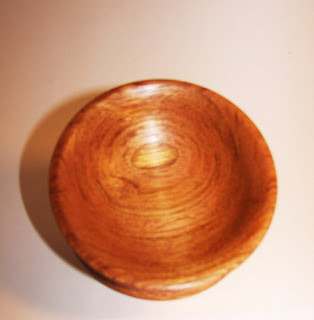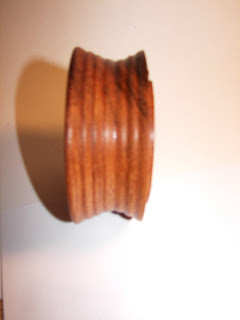Not posted in a while - but I've definitely been busy turning wood projects on my lathe. I've graduated to some finely turned bowls of mahogany, cocobolo, waterfall oak, burled oak and box elder maple. The latter two types came from my back yard. The first three were graciously supplied by my friend Ronno Cooke in NC. (See Ronno's work here: http://www.ronnocooke.com/). Always keep an eye out for great raw wood samples to turn: Your own yard or nearby woods; cut timber, trees or yard waste; make friends with fellow woodworkers and share smoe wood,; even turn great wood from old or ugly furniture pieces!
One recomendation - I purchased a David Ellsworth Pro-PM Gauge made by Crown Tools. It's expensive (Retail is about $125.00) but I was fortunate to pick mine up at a yearly sale at a local woodworker's shop. The quality, design, and feel of this tool blows all of my other (inferior) lathe tools out of the water! It is very solid, stays sharp much longer than my HSS tools, and it cuts incredibly well, especially on bowls. One of my ongoing goals is to expand my collection of tools - I'm searching flea markets, garage sales, and looking online at eBay and Craigs List. It pays to shop around - know quality tool brands and characteristics - and pick them up when you come across them.
I was at a flea market last week - and found a Pro Craftsman bowl gauge - complete with a waxed tip. I picked it up for $5. Brought it home and looked it up - I found the model in a 1966 Sears Catalog someone scanned online - it's from the year I was born! Back then, it cost $3.5. Best of all - the toll has never been used - it probably sat on someone workbench or at the bottom of their tool box, for 40+ years, until it fell in my waiting hands.
Here are a few projects I've completed:
A small bowl turned from mahogony:

and from the side:

The end result is a super smooth bowl, about 5 inches in diameter. I finished it with Tung Oil only - which really seems to bring out the depth in the mahogony grain. I've learned to use your tools to achieve a pleasing contour to the bowl, and to achieve as smooth a finish as possible. The inner contours should flow evenly from the center, through the outer edge. The surface should be flat and smooth, so that when sanding, there are no grooves, rough spots, raised grain, etc. Start with rougher grades and progressively smooth to finer grades (I end with about 400 grit).

